 |
 |
 |
| |
Virus-Related and AIDS Cancer Incidence Fell in HIV
Group But Still Exceed Rates in General Population
|
| |
| |
EACS 2023, October 18-21, 2023, Warsaw
Mark Mascolini
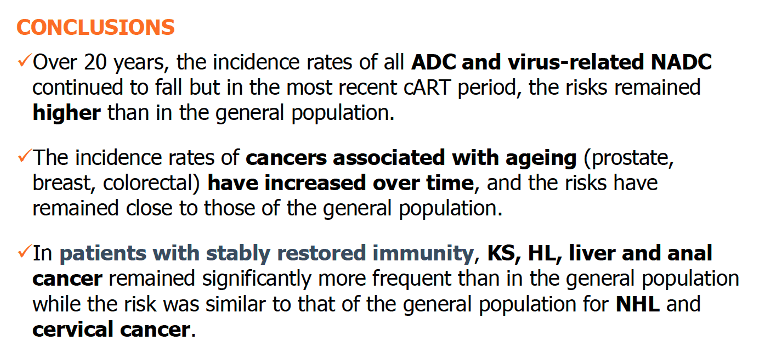
Incidence (new diagnoses) of AIDS cancers and virus-related non-AIDS cancers dropped over the past 20 years in a French HIV group [1]. But risk of these cancers remained higher in people with HIV than in the general population. Incidence of two aging-related cancers (prostate, colorectal) has climbed in people with HIV over the past two decades, as has lung cancer incidence in women with HIV.
Evolution of cancer in people with HIV travels down many paths, said ANRS researchers responsible for this study, from HIV-related immune suppression, coinfection with cancer-inducing viruses, and HIV itself to aging, comorbidities, and higher smoking prevalence in HIV groups. Starting today's stronger antiretroviral regimens at HIV diagnosis alters cancer's course down some of these paths and thereby may change cancer risk in people with HIV.
To see if cancer incidence has changed in the current antiretroviral age, researchers working with the ANRS CO4 FHDH cohort focused on 10 cancers: three AIDS-defining cancers (Kaposi sarcoma, non-Hodgkin lymphoma, cervical cancer); three virus-related non-AIDS cancers (Hodgkin lymphoma, liver, breast); and four virus-unrelated non-AIDS cancers (lung, colorectal, prostate, breast).
Researchers drew HIV-positive study participants from the ANRS CO4 FHDH, an open hospital cohort that has been adding people since 1989 and now includes about 218,250 people with HIV at 184 centers throughout France. To be included in the incidence analysis, cohort members had to live in mainland France, had to be 18 to 84 years old, and had to have follow-up sometime between 1997 and 2018. The general population in this analysis came from the French Network of Population-Based Cancer Registries, representing 19 French departments between 1992 and 2018. Researchers made statistical corrections for previous under-reporting of cancer cases in ANRS CO4 FHDH, particularly non-AIDS cancers [2].
To control for aging in the HIV population, the researchers used age-standardized incidence rates (IR) standardized on the age structure of the FHDH population in 1997-2018, separately for men and women. To estimate relative risk of cancer compared with the general population they used standardized incidence ratios (SIR). They aimed to determine cancer risk compared with the general population separately in people with HIV with restored immunity and controlled viral load in 2008-2018 (CD4 count above 500 continuously for at least 2 years with a viral load below 50 copies on the last measure). The researchers considered four periods: 1997-2001, 2002-2007, 2008-2012, and 2013-2018.
From 1997 to 2018 incidence of all three AIDS cancers dropped significantly in men who have sex with men (MSM), other men, and women. But compared with the general populations, SIR showed that risk of these three cancers remained significantly and sometimes substantially higher in people with HIV in 2013-2018 (Kaposi sarcoma in MSM, SIR 197.5; Kaposi sarcoma in other men, SIR 107.0; Kaposi sarcoma in women, SIR 466.9; non-Hodgkin lymphoma in men, SIR 13.5; non-Hodgkin lymphoma in women, SIR 11.9; cervical cancer in women, SIR 2.9).
Across the study years, incidence of virus-related non-AIDS cancers fell significantly in both men and women with HIV. The only exceptions were anal cancer in other (non-MSM) men, in whom incidence rose significantly, and anal cancer in women, in whom incidence did not change significantly. Again, incidence proved higher for all HIV groups than for the general population (Hodgkin lymphoma in men, SIR 11.6; Hodgkin lymphoma in women, SIR 5.8; liver cancer with HBV or HCV coinfection in men, SIR 21.3; liver cancer with HBV or HCV coinfection in women, SIR 20.5; anal cancer in MSM, SIR 58.4; anal cancer in other men, SIR 21.0; anal cancer in women, SIR 8.3).
From 1997 to 2018, incidence of lung cancer fell significantly in men with HIV and incidence of breast cancer fell significantly in women with HIV. But incidence of lung cancer in women with HIV and of the other two virus-unrelated non-AIDS cancers (colorectal, prostate) rose in men and women with HIV. Compared with the general population, incidence of lung cancer and colorectal cancer was only a hair higher in 2013-2018 in men and women with HIV (SIR 1.2 to 1.6). Incidence of prostate and breast cancer was a whisker lower in people with HIV than in the general population (SIR 0.9 and 0.8).
In HIV-positive people with a CD4 count above 500 and viral load below 50 copies, SIR-determined risk was still significantly higher than in the general population for Kaposi sarcoma and the three virus-related non-AIDS cancers (Hodgkin lymphoma, liver cancer, anal cancer) but lower for the four virus-unrelated non-AIDS cancers (lung cancer in current smokers, colorectal cancer, prostate cancer, female breast cancer).
The ANRS team offered three main conclusions:
- From 1997 to 2018 incidence of AIDS-defining cancer and virus-related non-AIDS cancer fell in people with HIV, but risks remained higher than in the general population.
- Incidence of aging-related cancers (prostate, breast, colorectal) rose over this period in people with HIV and risks remained close to those in the general population.
- In HIV-positive people with stably restored immunity, Kaposi sarcoma, Hodgkin lymphoma, liver cancer, and anal cancer remained more frequent than in the general population, while risk of non-Hodgkin lymphoma and cervical cancer was similar to that of the general population.
References
1. Grabar S, Lakrout P, Potard V, et al. Evolution of cancers risk in PWH over 20 years and risks when immunity is restored and viral load is controlled. Results from the ANRS CO4 FHDH cohort. EACS 2023, October 18-21, 2023, Warsaw. Abstract OS2.04.
2. Lanoy E, Spano JP, Bonnet F, et al. The spectrum of malignancies in HIV-infected patients in 2006 in France: the ONCOVIH study. Int J Cancer. 2011;129:467-75. doi: 10.1002/ijc.25903. https://onlinelibrary.wiley.com/doi/10.1002/ijc.25903

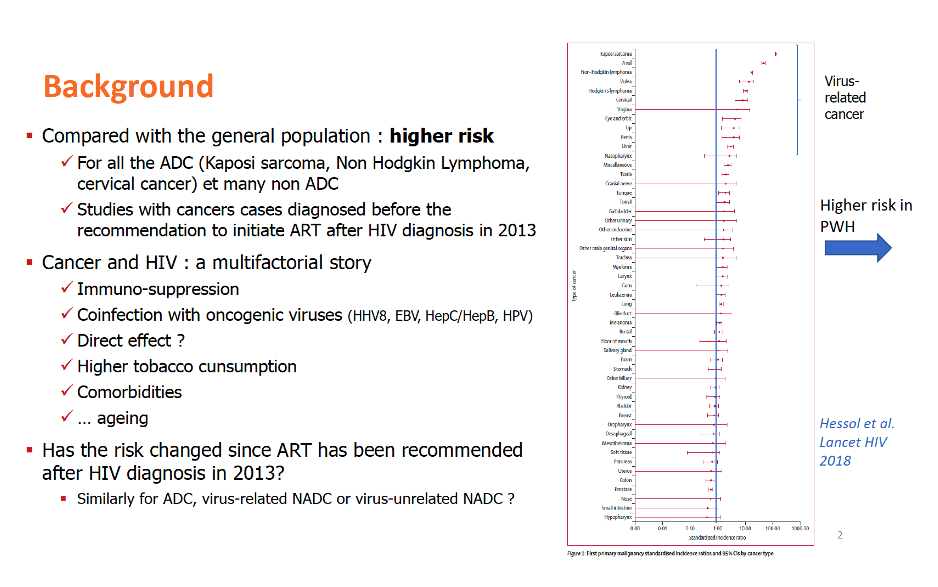
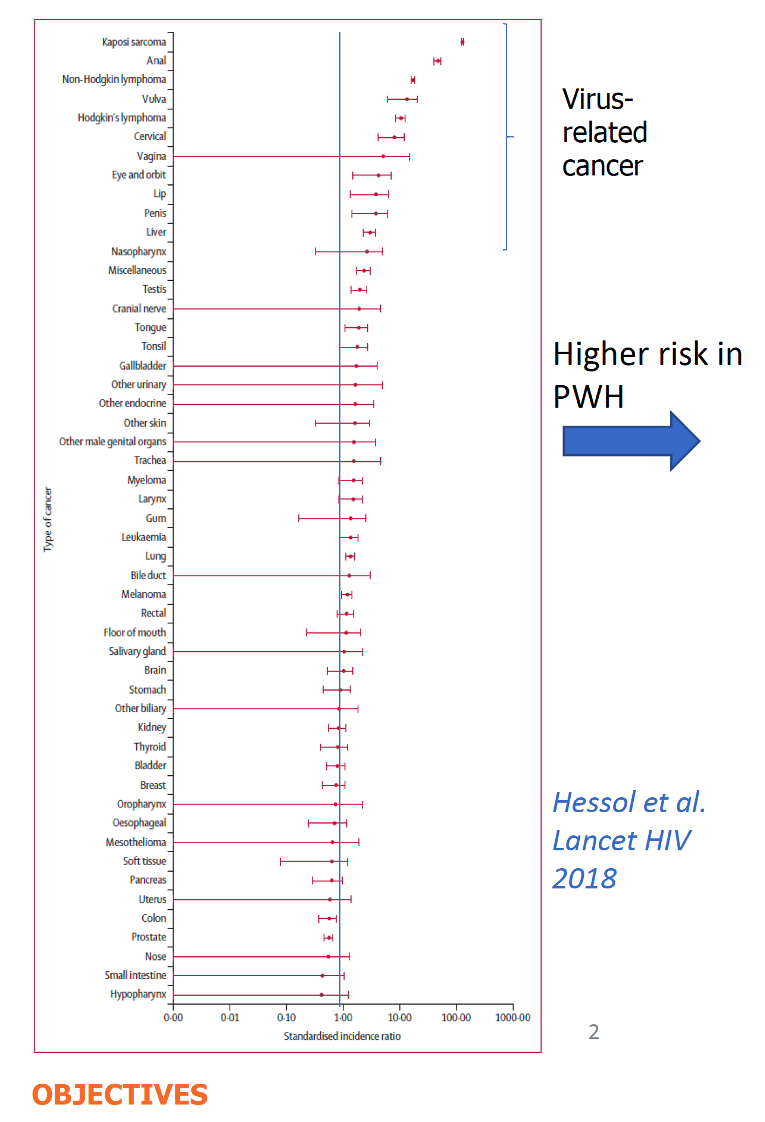
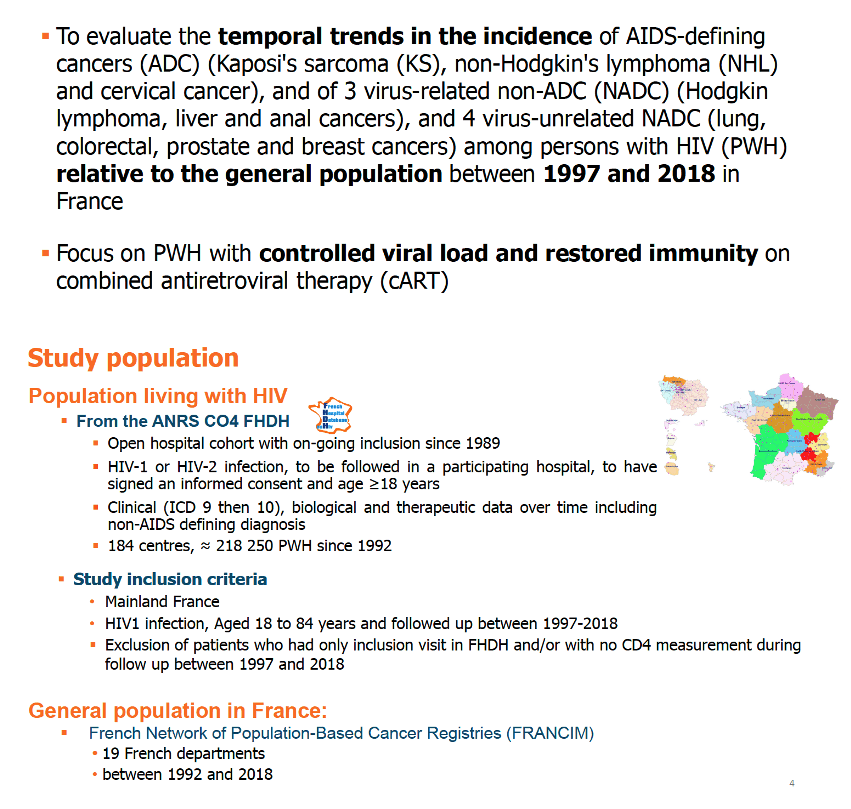
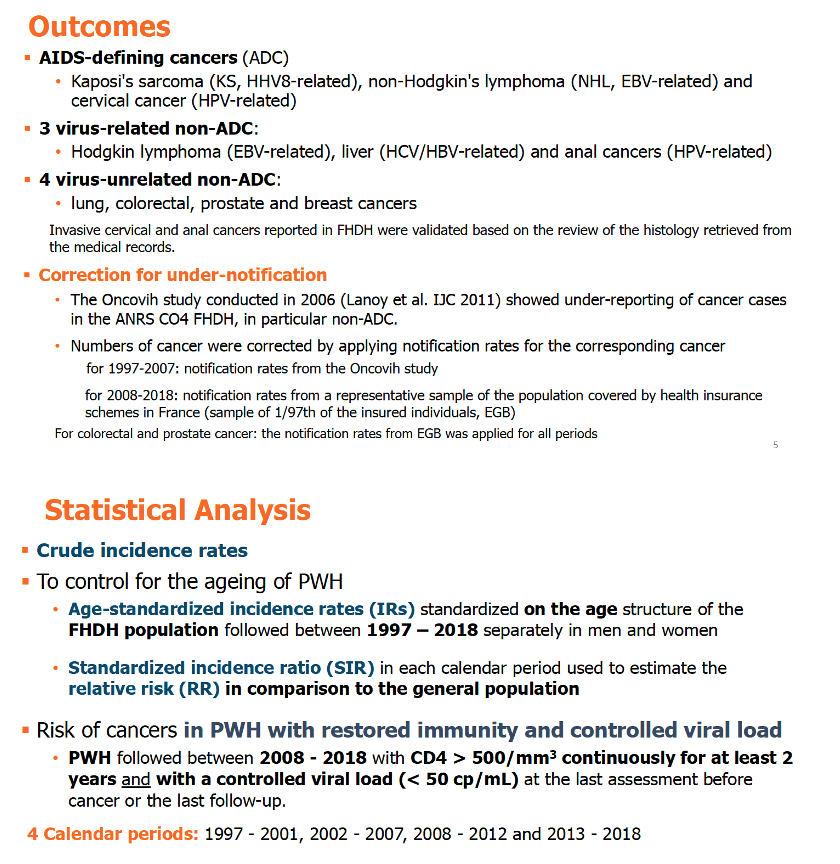

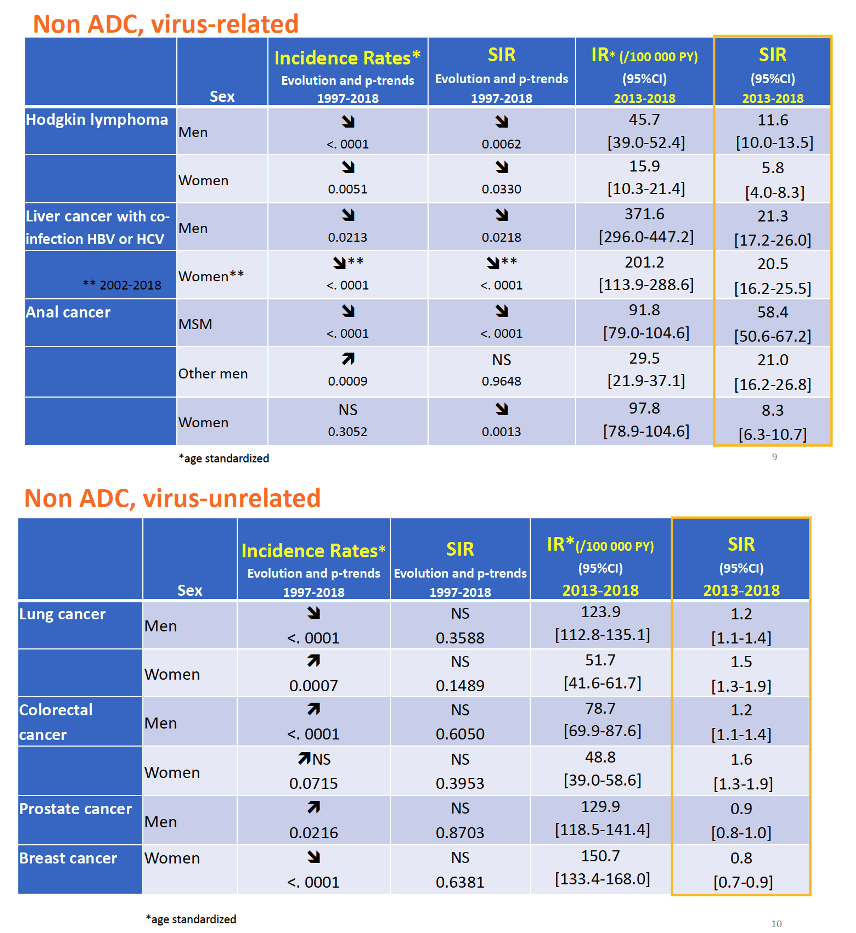
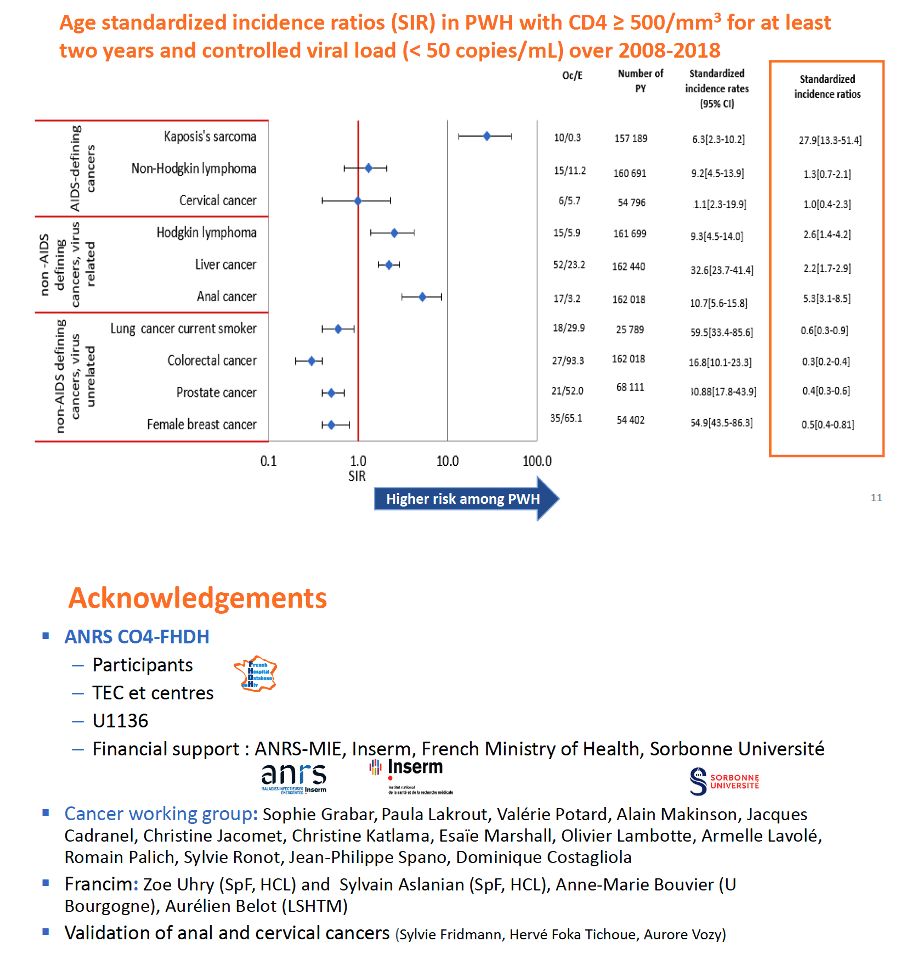
|
| |
|
 |
 |
|
|